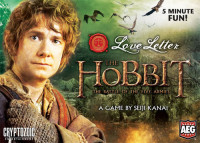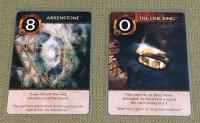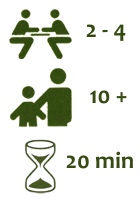Love Letter: The Hobbit – We’re in love

A few months ago we posted our review of Love Letter: Batman.
It’s a card game we’ve really loved playing.
Yet as much as we enjoyed playing it, we were very disappointed in the card art of the female characters. So we took our marker to those cards and made our own art adjustments to cover them up a bit.
It also prompted me to buy another version of the game — a version I was sure I was going to enjoy even before I bought it — Love Letter: The Hobbit – The Battle of the Five Armies.
And I’m not disappointed at all with this edition. We love it!
How to Play Love Letter: The Hobbit
Like all the Love Letter card games, Love Letter: The Hobbit is about knocking other players out of the game so you can be the sole survivor or have the highest rank card at the end of each round.

The beauty of Love Letter games is how simple yet re-playable they are.
They’re easy to teach, easy to remember, and easy to play.
If you’ve seen our review of Love Letter: Batman or are familiar with the basic game play of Love Letter, you may want to skip ahead to our “Differences” section below.
Love Letter: The Hobbit is played over several rounds.
To start each round, shuffle the 17 cards and set one card aside face-down. That card will be out of play this round.
Then each player draws a card. This card is their hand and is kept secret from the other players.
On a players turn, they do 2 simple things:
- Draw the top card from the draw pile.
- Choose one of their 2 cards in hand to play.
To play a card, the player simply discards it face up in front of them on the table and does what the cards says.

Here are the cards listed in order of increasing rank and their associated ability.
- 0. The One Ring (1 card) – When you discard the card nothing happens. It counts as 0 until the end of the round when players compare ranks in which it counts as 7.
- 1. Smaug (5 cards) – Name a card other than Smaug and choose another player. If that player has that card, he or she is out of the round.
- 2. Bard the Bowman (2 cards) – Look at another player’s hand/card.
- 3. Legolas (1 card) – You and another player secretly compare hands. The player with the lower rank is out of the round.
- 3. Tauriel (1 card) – You and another player secretly compare hands. The player with the higher rank is out of the round.
- 4. Gandalf The Grey (2 cards) – Until your next turn, ignore all effects from other players’ cards.
- 5. Kili and Fili (2 cards) – Choose any player (including yourself) to discard his or her hand and draw a new card.
- 6. Thorin Oakenshield (1 card) – Trade hands with another player of your choice.
- 7. Bilbo Baggins (1 card) – If you have this card and either Kili/Fili or Thorin Oakenshield in your hand, you must discard this card.
- 8. The Arkenstone (1 card) – If you discard this card, you are out of the round.
If a player is knocked out of the round, that player discards the card in their hand face up and doesn’t take any more turns that round.

Once a player’s turn is over, play passes to the player on the left.
As players play cards on subsequent turns, those cards will be added to the face-up cards already in front of them. This way all cards played so far can easily been seen on the table. And by process of elimination, remaining players will have a better idea of what cards may still be in other player’s hands.
Play continues this way until the round ends in one of two ways.
A round can end if the draw deck is empty at the end of a turn. All players still with a card in hand compare cards. The player with the highest rank card wins the round. If it’s a tie, the player with the highest total value of discarded cards wins the round.
A round can also end if all players but one are eliminated. Thus, the remaining player wins the round.
In either case, the winning player claims a gem.
Once a player has accumulated enough gems (depending on player count), that person wins the game.
Differences in Love Letter: The Hobbit
With the simplicity of Love Letter game play, there aren’t a lot of ways to alter the game. If altered too much, the game won’t be as streamlined and fun. So the differences are minimal, but noticeable — because they make for some interesting twists.

1. The first difference to note is that The Hobbit edition has 17 cards instead of 16. In this edition, The One Ring has been added as a zero rank card without any special abilities during play. If it’s discarded during play, nothing happens. But if held until the end, it counts as 7.
So when using Legolas or Tauriel to compare ranks of cards to knock someone out during the game, The One Ring will always be lowest rank card. But at the end of a round, it can jump a player ahead for the win.

2. The second noticeable difference is that the 3 rank cards aren’t the same. In the original and Batman editions of Love Letter, the 3 rank cards have a player compare hands with another player and the player with the lower card is knocked out.
But in Love Letter: The Hobbit, both Legolas and Tauriel are both rank 3 cards. The power of Legolas is the typical – lower rank card is knocked out. However, the power of Tauriel is that the higher rank card is knocked out of the round.
3. The last thing we’ll mention is a difference between the Batman edition and The Hobbit edition. In Love Letter: Batman, if a player uses Batman and correctly guesses the card of another player, the active player gains a Batman token. So in addition to getting a token for winning a round, a player can get additional tokens when guessing correctly.
That power doesn’t exist in Love Letter: The Hobbit. When a player using Smaug correctly guesses another player’s card to knock them out, they don’t also claim a gem.
While we enjoyed getting an additional reward for knocking players out with correct guesses, we don’t really miss it in The Hobbit edition. Because players in this edition don’t have to claim as many gems to win the game. In Love Letter: Batman it takes 7 tokens to win the game. In Love Letter: The Hobbit, it only takes 4 gems to win in a 4-player game (5 gems in a 3-player game, and 7 gems in a 2-player game).
The Fun of Love Letter: The Hobbit
Similarly to Love Letter: Batman, we’ve really enjoyed playing Love Letter: The Hobbit. And as I mentioned at the start, The Hobbit edition is now our go-to version to play.
We love the simplicity and we love the interaction.
It’s the interplay of all the cards that makes the game a lot of fun to play. And it seems to get more fun each time we play.
How does Love Letter: The Hobbit score on our “Let’s Play Again” game meter?
 I think it’s pretty obvious that Love Letter: The Hobbit scores extremely high on our “let’s play again” game meter.
I think it’s pretty obvious that Love Letter: The Hobbit scores extremely high on our “let’s play again” game meter.
We love how easy it is to grab and dive into playing.
Because of how much we figured we’d be playing Love Letter: The Hobbit, one of our first items of business was to sleeve the cards.
We don’t typically do that for our card games. But in a game like this, where not knowing what the other players are holding is a key element of the game, marked cards would ruin the fun.
So right from the outset we sleeved the cards to protect them from the inevitable multiple plays this game would get.
Love Letter: The Hobbit comes highly recommended from our family to yours!
At under $15, it’s a great deal.
| The Board Game Family Game Ratings | |
| Caleb | |
| Brooke | |
| Jaden | |
| Trevor | |
| Mom | |
| Dad | |
| Average | |


